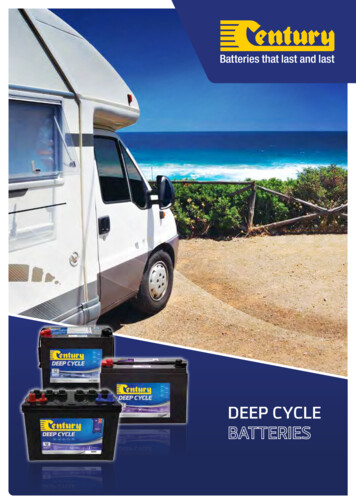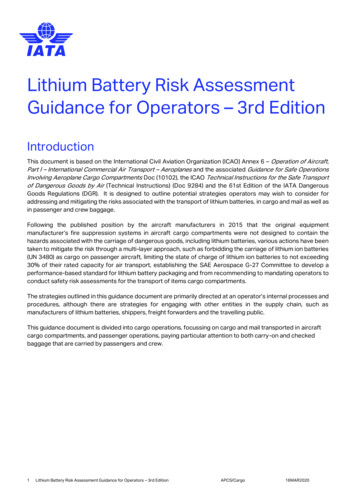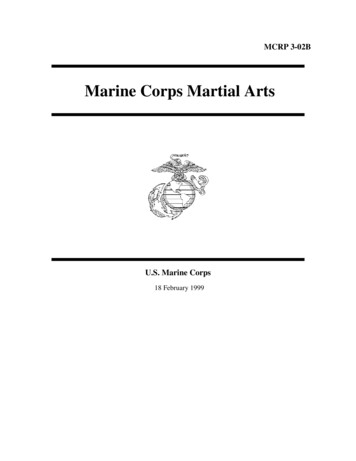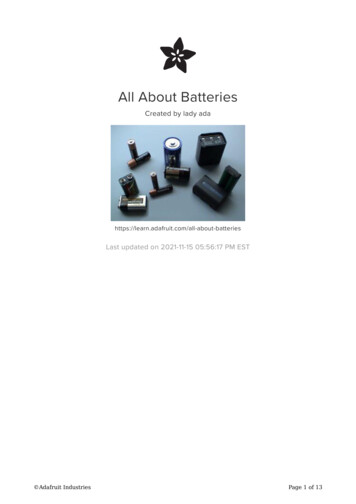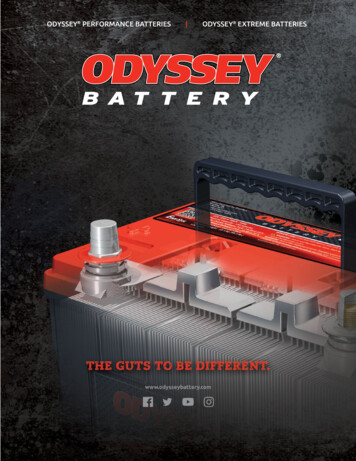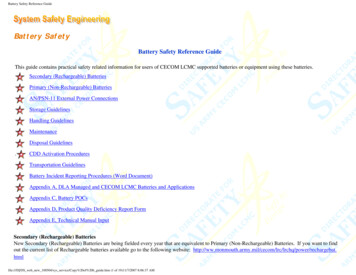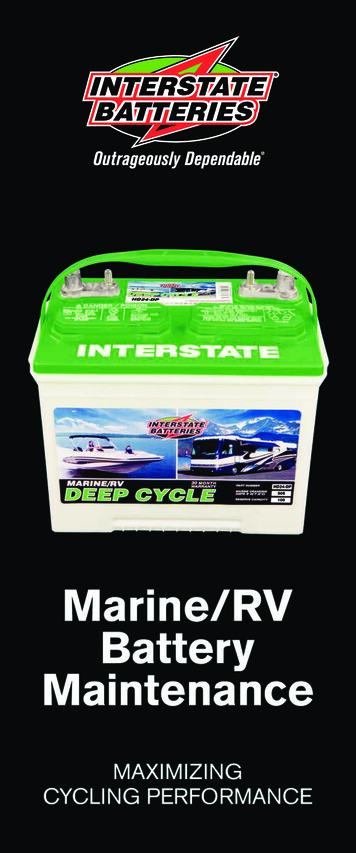
Transcription
Marine/RVDeep-CycleBatteriesHD24-DPTable of ContentsAn Introduction toMarine/RV Deep-Cycle Batteries . . . . . . . 2Deep-Cycle Batteries . . . . . . . . . . . . . . . . . 2Sealed Lead-Acid vs. Flooded Lead-Acid . . . 2Deep-Cycle Sealed Lead-Acid Batteries . . 2Proper Deep-Cycle Application . . . . . . . . . 3SRM-24What Is a Cycle? . . . . . . . . . . . . . . . . . . . . . 3Types of Cycles . . . . . . . . . . . . . . . . . . . . . . 4Cycle Life . . . . . . . . . . . . . . . . . . . . . . . . . . 4Determining BatteryDepth of Discharge/State of Charge . . . . 5SRM-27Ratings and Specifications . . . . . . . . . . . . 6Battery Charging . . . . . . . . . . . . . . . . . . . . 7The Interstate BatteriesCycling Lineup . . . . . . . . . . . . . . . . . . . . . . 8What Makes a Deep-CycleBattery Distinctive? . . . . . . . . . . . . . . . . . . 8General Charger Information . . . . . . . . . 10GC2-XHDTrickle Charging . . . . . . . . . . . . . . . . . . . 10FAQs . . . . . . . . . . . . . . . . . . . . . . . . . . . . . 11Interstate’s Marine/RV StartingBatteries . . . . . . . . . . . . . . . . . . . . . . . . . . 17Typical Applications . . . . . . . . . . . . . . . . . 17SRM-291
An Introductionto Marine/RVDeep-Cycle BatteriesThere are many misunderstandings regardingMarine/RV deep-cycle batteries. This booklet isdesigned to clarify terminology and misconceptions and to assist you, the customer, in1. making an informed decision regardingproper usage,2. extending overall battery service life, and3. m aintaining battery performance atoptimum levels.Deep-Cycle BatteriesThe term “deep cycle” refers, in general, to abattery that has the capability of deeplydischarging hundreds of times. Deep-cyclebatteries are either liquid electrolyte or sealedlead acid. How do they differ from otherbatteries? An automotive starting batteryis manufactured specifically to provide aquick burst of energy thousands of times inits lifetime, while only being able to deeplydischarge less than 50 cycles during its life.Sealed Lead-Acid VersusFlooded Lead-AcidMarine/RV deep-cycle batteries are available intwo different lead-acid types. A flooded or liquidelectrolyte battery has vent caps to allowmaintenance, and a sealed lead-acid battery iscompletely sealed or maintenance-free. Eachis available in common battery group sizes andhas similar ratings (CCA, RC, and Ah). TheSLA battery is used where the battery or batterybank is not easily accessible. Maintenance onthe flooded battery includes checking electrolyteand adding distilled water.Deep-Cycle Sealed Lead-AcidBatteries (SLA)Interstate offers a wide selection of SealedLead-Acid (SLA) batteries for Marine/RVuse, including both Gel Cell and AbsorbedGlass Mat (AGM) types. Because they do notrequire maintenance, many consumers preferthem. And, for applications with hard-to-reachbatteries, SLA batteries are ideal.2AGM and Gel batteries are completely sealedso absolutely NO corrosion occurs. While bothAGM and Gel types are lead-acid batteries,neither will expel external gasses, such ashydrogen and oxygen during recharge. Theycombine gasses internally.Note that AGM technology has advanced inrecent years and is now available in Marine/RVdeep-cycle and automotive starting batteries.Important: Please remember, both AGM and Gelbatteries should be recharged with a chargerthat is specifically designed for SLA batteries.When AGM or Gel batteries are used to replaceliquid electrolyte batteries, always check withthe vehicle or battery manufacturer for information about charging requirements.Proper Deep-CycleApplicationA Marine/RV deep-cycle battery can be use forvarious applications including boats, motorhomes,sailboats, travel trailers, tent campers, etc. Anytimean application indicates a need for batteries thatcan provide repeated deep discharge, you needMarine/RV deep-cycle batteries.What Is a Cycle?A cycle refers to one battery discharge andrecharge of any depth (See Figure 1). Theamount of battery discharge (in percent) compared to its full capacity determines the needfor a shallow, moderate or deep cycle. This isappropriately called battery depth of discharge(DOD) and is measured in percentages.FULLCHARGEREDUCEDCAPACITYTIME OF OPERATIONFIGURE 13
For example, 40% DOD indicates that a batteryhas been discharged by 40% of its total capacityand has a 60% state of charge remaining.Types of CyclesThere are three primary types of batterydischarge cycles: shallow, moderate and deep.These terms help us understand the type ofcycling that batteries experience. To clarify, let’stake a look at all three types. Shallow cyclesoccur when only a small percentage of the totalbattery capacity is discharged. Following thatTherefore, to optimize performance of a Marine/RVdeep-cycle battery, it is recommended that theconsistent discharge level not fall below 50%.Remember, many other factors affect battery cyclelife. If the battery is operating in a high heatenvironment (consistently above 90 F), the typicalnumber of cycles could be drastically reduced.same line of thought, moderate or deep cyclesare discharged by a higher percentage of thebattery’s total capacity (See Figure 2).Cycle LifeHow many cycles should a Marine/RV deep-cycle battery produce inits life? Battery cycle life is difficult to calculateand is dependent on multiple variables, includingbattery maintenance, proper recharge, batterydepth of discharge, battery temperature, cyclinguse, vibration, and overall care and consideration.One of the more important factors is the battery’sdepth of discharge (DOD) level per cycle. As theamount of DOD is increased per cycle, there isa resulting decrease in the amount of total cyclelife and available performance retention (SeeFigure 3). If, for example, a battery is dischargedconsistently to 100% DOD (considering all othervariables are consistent), the battery’s total cyclelife can be reduced to much less than one-half ofa battery discharged to only 50%.4VOLTAGESPECIFICGRAVITYSTATE OFCHARGEDEPTH 2.051.14525%75%11.901.1000%100%FIGURE 4Determining Battery Depthof Discharge/State of ChargeBattery DOD (in percent) is the opposite ofbattery state of charge. For example, if thebattery has a 70% state of charge, the depth ofdischarge is 30% since the total must be 100%(See Figure 4). The most efficient means ofdetermining the battery’s state of charge/depthof discharge on removable-filler-cap batteriesis by using a hydrometer. On maintence-freebatteries, an accurate digital voltmeter is thebest method.5
Surface ChargeSurface charge, in general terms, refers toan inflated charge level immediately after thebattery has been charged. Surface charge affectsa voltmeter test of the battery’s state-of-chargelevel more than a hydrometer test. As anexample, even hours after a charge , testing thebattery voltage and reading 12.66 –12.75 voltsmay not be a true indicator that the batteryis fully charged. To remove battery surfacecharge, apply a load to the battery for a periodof time. For example, apply 10–15 amps for twoto three minutes, then allow the battery to sitfor one minute before retesting.Ratings and SpecificationsMarine/RV deep-cycle batteries have ratingspecifications that include cold cranking amps(CCA), marine cranking amps (MCA), reservecapacity (RC) and ampere hours (Ah). RCand approximate Ah ratings may not be listedon the battery decal. However, they are available through your local Interstate BatteriesDistributor. Unless specified, the Ah ratings arebased on a 20-hour discharge.Cold Cranking Amps (CCA) CCA isthe amount of current (amps) a battery at 0 F(-17.8 C) can deliver for 30 seconds whilemaintaining at least 1.2 volts per cell (7.2 voltsfor a 12-volt battery).Marine Cranking Amps (MCA)MCA is the amount of discharge current abattery tested at 32 F (0 C) can deliver for 30seconds and maintain at least 1.2 volts per cell(7.2 volts on a 12-volt battery).Note: Interstate Batteries uses the RCrating established by Battery CouncilInternational (BCI). Some manufacturersuse a 15 or 23-amp discharge rate ratherthan 25-amp discharge. The lower dischargelevel allows a higher number of minutes tobe displayed (on the battery label) whichdoes not reflect the true RC minutes at a25-amp discharge.6Reserve Capacity (RC) RC is theamount of time a battery can deliver 25 ampsat 80 F (26.7 C) without falling below 1.75volts per cell (10.5 volts on a 12-volt battery).5 AMPS 10 AMPS 15 AMPS 20 AMPS 25 2212.59.17.0FIGURE 5Ampere hours (Ah) tested at 80 F. It isthe amount of current (in amps) that a batterycan deliver, multiplied by the amount of hours,without falling below 1.75 volts per cell (10.5volts on a 12-volt). Most Marine/RV deep-cyclebatteries are rated on a 20-hour discharge rate.Example: A 100Ah battery can deliver five amps for20 hours (amps x hours Ah).Battery ChargingUtilizing the correct charger and followingproper charging methods is one of the primarykeys to enhancing battery service life andperformance. Always choose a chargerspecifically designed to match the chargingrequirements (voltage and current) of thebattery or battery pack. If the charger unit isan on-board charger unit (i.e., alternator,generator, converter), validate its compatibilityand proper operation before or immediatelyafter installation of a newbattery. Never allow a batteryto become overcharged oroverheated. If the batterybecomes “hot to the touch”on the outside casing,immediately disconnect thecharger and allow the batteryto cool down before continuing.7
The Interstate Batteries Cycling LineupSuperior Quality Product Advantages:DEEP-CYCLE:more densepaste withfewer poresWhat Makes a Deep-CycleBattery Distinctive?Several qualities separate deep-cycle batteriesfrom starting types: thicker plates, denseractive chemical plate material and a speciallyformulated grid alloy. These and other addedfeatures allow the Interstate Marine/RVdeep-cycle batteries to withstand the severe,repeated stress deep cycling creates.8STARTING:less densepaste withmore pores9
General ChargerInformationVarious types of chargers may be used onMarine/RV deep-cycle batteries. Most chargers,both onboard and external, are parallel-typechargers that have the capacity of reducingor tapering the current (in amps) whileregulating voltage.Although almost any type of charger willrecharge a Marine/RV deep-cycle battery tosome degree, short-term performance and longterm service life are directly proportional toproper recharging. It is recommended that you: Choose the correct charger that matches thetype of battery you intend to recharge, i.e., liquidelectrolyte, Marine/RV, deep cycle, automotive,maintenance-free or AGM. Match the proper battery voltage(6-, 12-, 24- or 36-volt). Choose the correct charger size in amps.A good rule of thumb: A charger should providea maximum of 20 amps for each 100 Ah ofthe battery. Select a charger with a capacity sufficientto fully recharge the batteries within eightto 12 hours. For optimum results, choose a maintenancefree type charger that is timed or automaticallyshuts off when the battery reaches a full stateof charge. Always read and follow the charger instructionmanual’s safety and proceduralrecommendations. Differentmanufacturers offervarious features thatmay influencecharging parameters.Charging Tip: Do notdelay charging your batteries afteruse. Recharge as soon as possible after oneday’s use. Allowing the battery to sit discharged forseveral days may hamper its recharge acceptanceand ultimately its performance.Trickle ChargingThe term trickle charger is often used todescribe a low-current, inexpensive charger.Some trickle-type chargers may lack the10sophisticated electronic integrated circuitryto properly regulate current and/or voltage.A charger that lacks accurate voltage/currentregulation should not be used for prolongedbattery charging, or damage could occur.Some chargers have manual timers to allowa battery charge to be set for a few minutesup to several hours. Always monitor abattery during charge, whether it is onan automatic or manual setting.Frequently AskedQuestions1. How important is an Ah rating?The Ah rating is important when determiningthe type and amount of battery or batteriesrequired to meet your specific componentloads. The battery’s RC rating is in directcorrelation with Ah. An approximate Ah ratingcan be attained by multiplying the battery’s RCrating by 0.6. Example: 180 RC x 0.6 108 Ah.2. Should I completely dischargea deep-cycle battery the first fewtimes I use it? No! A Marine/RV deepcycle battery does not require a complete discharge at any time in its service life. In fact, forbest results, it is recommended to shallow ormoderately discharge the first five to 20 cycles.3. Do Marine/RV deep-cyclebatteries develop a memory? No!Lead-acid batteries do not develop a memory.What does this mean to you? Lead-acid batterieshave the ability to cycle to various amounts ofDOD anytime during their service life withouta memory developing inside the battery.4. Which is the most detrimentalto a battery, heat or cold? Bothextremes create battery problems. Extremeheat will allow the battery to increase itsshort-term performance level. However, heatinternally accelerates corrosion and otherdeterioration factors that reduce a battery’slife. Extreme cold battery temperatures resultin an immediate reduction of battery efficiencylevel, which reduces short-term performance.For example, a fully charged battery at 80 F11
(26 C) should operate with 100% efficiency, at32 F (0 C) with 65% efficiency, and at 0 F(-17.8 C) with 40% efficiency.6. When do I need additionalbatteries? When your power requirementsexceed the Ah your battery system can provide,you will need to connect additional batteries toyour system or increase the individual batterysize (capacity). If you are consistentlyreplacing the battery or batteries beforethe warranty has expired, the capacity inyour system may not be adequate to supplyyour needs.Tip: Once a year, re-evaluate your total batteryneeds and vehicle load requirements. If you haveadded any accessories over the past year or thehours of usage have increased, increase your totalbattery capacity.APPROXIMATEBATTERY Ah (@12V)3 cu.ft. REFRIG.5. How do I select the propertype and amount of batteriesto fit my needs? Determine your total power requirements. Determine approximate time of use. Multiply hours by amps. Divide total ampere hours by 0.50 (50%DOD) to maximize battery cycle life.Tip: When choosing a battery or batteries fortrolling motors, know that a 12-volt system requiresa minimum of 1.1 to 1.2 amps per pound of thrust. A24-volt system requires 0.85 to 0.95 amps per poundof thrust. And a 36-volt system requires 0.5 to 0.55amps per pound of thrust.127. As a battery ages, doesefficiency decrease? Normally, aproperly charged, Marine/RV deep-cycle battery’sefficiency improves slightly after the first 10 to20 cycles. As a battery ages, its maintenancerequirements change. Near the end of usefulservice life, however, the battery will start tolose efficiency, decreasing performance andincreasing maintenance.8. Is it best to slow chargea Marine/RV deep-cycle battery?Yes! As previously mentioned, a Marine/RV deepcycle battery should be charged at a slow currentrate. Typically, a 10- to 20-amp charger is normallylarge enough to recharge a battery of 100 Ah withineight to 12 hours. A charge level of one to two ampsis often acceptable, however, the battery should bemonitored periodically due to the extended chargetime. It is best to choose a charger that has anautomatic shut-off capability. This type of chargernormally monitors the battery’s charge level electronically, then shuts off completely, or maintainsthe battery’s state of charge.9. Are the Interstate floodedMarine/RV deep-cycle batteriesmaintenance-free? Interstate Marine/RV,deep-cycle, liquid-electrolyte batteries are “lowmaintenance.” This means that maintenancecan be performed, but under normal conditionsis seldom needed. Interstate also offers sealedlead-acid batteries which are maintenance-free.13
10. How do I know if my charger iscorrect for the battery’s chargingneeds? Check and/or test the battery orbatteries every four to six weeks. This actionwill determine whether your onboard or externalcharger is operating in harmony with yourbattery system. For example, if your batteriesare using an excessive amount of water (additional water needed every two to three weeks),the charger may be overheating and/or overcharging your batteries. If your batteries arenot meeting the performance expected, thecharger may be undercharging the batteries. Ifthe batteries are low-maintenance, test with ahydrometer. A low state of charge will hamperthe performance and service life of the battery.11. Do I need to equalize mybatteries? When the specific gravity ofindividual cells in a battery or bank of batteriesbecome unequal by more than 15 points or whenthe battery will not come up to full charge usingnormal charging methods, an equalization chargeis needed. An equalization charge is a batterycharge at a slightly higher voltage than normal.On a 12-volt battery system, this may be 15.5 voltsto 16.2 volts.So how do you know if your batteries need anequalization charge? It depends on the batterytype and manufacturer. With normal use,starting (or chassis) batteries do not requireany equalization throughout their service life. Insome household or deep-cycle applications, anequalization charge may be necessary. Sealedlead-acid batteries do not require an equalization charge.Caution: Due to the higher-charge voltage requiredwhen equalizing, it is necessary to consult and followvehicle and battery manufacturer’sguidelines. Some vehicle manufacturers requirecomplete battery disconnection from the vehicle’selectrical/electronic system prior to an equalizationcharge. Always monitor the batteries duringan equalization charge. If the batteries become“hot-to-the-touch” or spew acid, disconnectimmediately!12. When do I need to add waterto my batteries? If the vehicle’scharging system is working well with thebatteries and adequate time is allowed toproperly recharge, additional water may not benecessary. It is important to remember thatall flooded, lead-acid batteries gas H2O duringcharging, so you should never add premixedelectrolyte to your battery! Add water, preferably distilled, when the electrolyte level fallsbelow 1/2” above the plates. Do not overfill.Do not fill the cell higher than 1/8” belowthe battery’s internal vent-well. Overfillingthe battery can result in increased water lossand post corrosion. Remember, as batteriesnear their end of life, they often requiremore maintenance.13. Will it damage my batteriesto sit for weeks or months?A battery sitting unused can deteriorate fasterthan a battery that is used (recharged) daily.As a battery sits, the chemicals inside thebattery react, discharging the battery. Thisprocess is called battery self-discharging.Depending on the battery type and temperature,the rate of self-discharge varies. For example, atypical liquid-electrolyte Marine/RV battery keptat a constant 80 F (26.7 C) may self-dischargeapproximately 25% of its capacity in three to fourmonths. If the battery has any type of vehicle electrical discharge, like maintaining sensor voltage,the battery will discharge more quickly. The batterywill not be damaged if it is recharged properly.Tip: If the battery is used seasonally or sporadically, place a fully-automatic charger on the batteryfor a few hours each week. Please remember tomonitor batteries during recharge.12 VOLTS500 CCA120 RC12 VOLTS500 CCA120 RC24 VOLTS, 500 CCA, 120 RCFIGURE 91415
Interstate’s Marine/RVStarting Batteries12 VOLTS500 CCA120 RC12 VOLTS500 CCA120 RC12 VOLTS, 1000 CCA, 240 RCFIGURE 10These batteries are used primarily in themarine industry for starting purposesonly. They are built “Interstate-tough” towithstand the most rugged conditions andhave these quality features: Four-post design Carrying handles Calcium/calcium chemistry Vibration-resistant technology High density active chemical material Na2SO4 additive Negative plate paste expanderTypical Applications12 VOLTS500 CCA120 RCChoose the Correct Interstate Product to Fit Your Needs12 VOLTS500 CCA120 RC12 VOLTS500 CCA120 RC12 VOLTS500 CCA120 RCIBS PART NO.APPLICATIONCCAMCARC@25A24M-RDEngine starting4005007524M-HDEngine starting5006259524M-XHDEngine starting800 100013527M-XHDEngine starting800 1000180SRM-24Engine starting,trolling motors(24/36-volt), poweraccessories*550690140SRM-27Engine starting (over 6007000 watts at 0ºF)trolling motors (12;24-, 24/36-volt), fullline poweraccessory options750160SRM-29Engine starting (over 6758000 watts at 0ºF),trolling motors (12;24-, 24/36-volt), fullline power accessoryoptions845210GC2-XHDDeep Cycle use only.Designed to operate full line poweraccessory optionsin 12-, 24- or 36-voltcombinations–47524 VOLTS, 1000 CCA, 240 RCFIGURE 116 VOLTS225 Ah6 VOLTS225 Ah6 VOLTS225 Ah6 VOLTS225 Ah–*Power accessories include fish finders, auto pilot,invertors, safety systems, blowers and lighting.FIGURE 1312 VOLTS, 450 AhFIGURE 1216Interstate Batteries offers a complete line of sealed AGM,Marine/RV deep-cycle batteries. Contact your local Interstatedistributor for more information about various product lines.17
Call 1-800 Crank-It for a dealer near you.InterstateBatteries.com 2010 Interstate Battery System International, Inc. 3/10 200004 BM
SLA battery is used where the battery or battery bank is not easily accessible . Maintenance on the flooded battery includes checking electrolyte and adding distilled water . Deep-Cycle Sealed Lead-Acid Batteries (SLA) Interstate offers a wide selection of Sealed Lead-Acid (SLA) batteries for Marine/RV . use, including both Gel Cell and Absorbed
